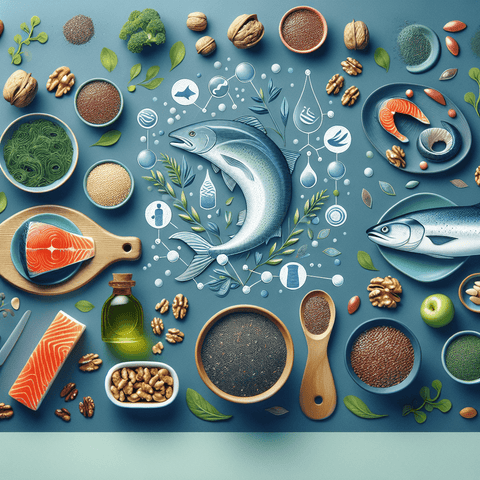Introduction
Omega-3 fatty acids are a crucial component of a balanced diet and are known for their fundamental role in supporting various aspects of human health. These polyunsaturated fats are essential nutrients, which means the human body cannot produce them on its own; instead, they must be obtained through food or high-quality supplements. Unlike saturated fats, omega-3s are recognized for their potential in maintaining normal brain function, normal visual development, and contributing to the maintenance of normal heart function when consumed in adequate quantities.
Omega-3s exist in several forms, primarily eicosapentaenoic acid (EPA), docosahexaenoic acid (DHA), and alpha-linolenic acid (ALA). DHA and EPA are mostly found in marine sources such as oily fish and certain algae, while ALA is commonly derived from plants like flaxseed and walnuts. Achieving the right balance of these fatty acids via diet or supplementation is essential for optimal health.
While omega-3 supplements such as DHA and EPA omega-3 capsules are popular for those seeking an easy and effective way to boost intake, incorporating naturally omega-3-rich foods also brings other healthful nutrients into the equation. This comprehensive guide from Topvitamine.com explores the top food sources of omega-3 and evaluates how these integrate with or complement supplementation strategies—including options suitable for vegans and vegetarians.
In this post, we will walk you through the most omega-3-rich foods from both animal and plant origins, how they contribute to your nutritional goals, and how they fit into a broader supplement regimen. Whether you're trying to increase fish intake, explore vegan sources, or decide between food and supplement options, you'll find the insights you need right here.
1. Omega 3 Foods Relevant to Nutritional Supplements: An Introduction
Omega-3 fatty acids come in three primary types: EPA (eicosapentaenoic acid), DHA (docosahexaenoic acid), found mainly in animal sources like fatty fish and algae, and ALA (alpha-linolenic acid), predominantly present in plant-based foods such as flaxseeds and chia seeds. These are crucial to various physiological processes, including cell membrane function, neurological health, and the regulation of inflammatory pathways.
EPA and DHA are classified as long-chain omega-3 fatty acids. These are the forms most readily absorbed and utilized by the body to support cardiovascular and brain health. On the other hand, ALA is a short-chain fatty acid that serves as a precursor to EPA and DHA. However, the human body’s ability to convert ALA to EPA and DHA is limited, estimated at under 10%, highlighting the importance of direct dietary sources or supplementation for these fats.
Choosing the right omega-3 food sources matters not only due to bioavailability but also because of the broader nutritional benefits these sources offer. For example, fish don’t only contain DHA and EPA—they are also rich in protein, selenium, iodine, and vitamin D. Similarly, flaxseeds are high in soluble fiber, beneficial plant lignans, and magnesium, which supports muscle and bone health. Foods therefore provide a multifaceted approach to nutrition, something that makes them highly complementary to supplementation.
Supplements are incredibly useful in situations where dietary intake may be inadequate or when health professionals recommend higher intakes of EPA and DHA for specific needs. They ensure consistent consumption levels and eliminate concerns around contaminants like mercury which may be present in some fish. Integrating omega-3-rich foods with scientifically backed supplements, such as those from Topvitamine’s omega-3 category, can help bridge the nutritional gap effectively.
Understanding the interplay between dietary and supplemental sources heightens the potential to meet individual health needs while also allowing for enjoyable, flavorful additions to meals. For instance, instead of relying entirely on capsules, a balance of baked salmon, chia seed pudding, and a flax-enhanced smoothie can create a sustainable and delicious omega-3 intake plan. This integrative approach is increasingly recognized in both clinical and lifestyle nutrition strategies for long-term wellness.
2. Fish Oil Sources: The Classic Omega 3 Supplement and Food Option Tips
Fish and fish oil supplements are some of the most well-established sources of DHA and EPA—long-chain omega-3 fatty acids known to contribute to the maintenance of normal heart function with a daily intake of at least 250 mg of EPA and DHA. Fatty fish like salmon, mackerel, sardines, and anchovies are especially concentrated in these omega-3s, making them dietary staples for those aiming to boost their intake naturally.
Salmon, particularly wild-caught varieties, is an omega-3 powerhouse, delivering up to 2,000 mg of EPA and DHA per 100-gram serving. This makes it one of the most efficient whole food sources available. Mackerel, while smaller, is similarly rich in omega-3s and has the added benefit of a shorter lifespan, reducing its mercury accumulation. Sardines and anchovies, both small and oily, offer the dual advantage of high omega-3 concentration and sustainability, given their rapid reproduction and lower position on the food chain.
Incorporating fish into the diet two to three times per week is a commonly recommended strategy for achieving sufficient omega-3 levels through food. This can include traditional recipes like grilled salmon, sardine sandwiches, or pasta dishes flavored with anchovy fillets. Canned fish is another excellent, convenient choice. Mercury and environmental contaminants are a concern, particularly with larger predatory fish like tuna and swordfish, so opting for sustainably sourced options is key to safe consumption.
Fish oil supplements offer an alternative for individuals who cannot or choose not to consume enough fish regularly. High-quality options, like those in the Topvitamine omega-3 supplements collection, often contain concentrated EPA and DHA and are purified to remove potential contaminants. These supplements come in various forms—liquid, soft gel, or even flavored emulsions—suitable for different preferences and age groups.
Comparing fish to supplements, the major benefit of whole fish lies in its nutritional complexity. While omega-3 capsules deliver purity and potency, fish offer additional nutrients like high-quality protein and vitamins B12 and D. The best strategy may be an integrative one: enjoy fish meals routinely and use supplements as a consistent, measurable way to meet omega-3 goals on a daily or weekly basis—especially if dietary access or time constraints interfere.
3. Plant-Based Omega 3: Vegan and Vegetarian-Friendly Sources and Their Supplement Equivalents
For individuals following vegan or vegetarian diets, plant-based sources of omega-3s serve two purposes: providing essential ALA and supporting an overall anti-inflammatory and nutrient-dense dietary pattern. Although ALA is a precursor to EPA and DHA, its conversion rate in the human body is limited. Nevertheless, incorporating a variety of ALA-rich foods is a pivotal strategy for those who do not consume animal products.
Flaxseeds are among the most well-known plant sources of ALA, providing approximately 6,300 mg per tablespoon of ground seeds. They’re highly versatile and can be sprinkled onto yogurt, incorporated into smoothies, or used as an egg substitute in baking. Chia seeds are another excellent option, with around 5,000 mg of ALA per tablespoon. In addition to their omega-3 content, they bring soluble fiber, protein, and various micronutrients to the table.
Walnuts, with approximately 2,500 mg of ALA per small handful, are not just omega-3-rich—they’re also a good source of antioxidants and polyphenols. Hemp seeds round out the top-tier of plant-based omega-3s, offering around 2,000 mg of ALA per serving and providing magnesium, iron, and zinc alongside essential fatty acids. These seeds can be added to salads, oatmeal, or yogurt-like dairy alternatives for a consistent boost in omega-3.
However, because ALA’s conversion to DHA and EPA is inefficient, vegetarians and vegans may benefit from supplementing with algal oil-based products. Algae, the original source of DHA and EPA for fish, provides a bioavailable, sustainable plant-based alternative. Topvitamine’s collection of algae-derived supplements offers these essential long-chain omega-3s in vegan-friendly softgels.
Ultimately, a plant-based omega-3 strategy aims to balance various sources of ALA while ensuring the intake of DHA and EPA through targeted supplements. Using nutrient-dense foods like chia pudding, walnut-studded salads, and flax-fortified smoothies can make plant-based diets not only ethical and environmental but also biologically effective in meeting omega-3 needs.
4. Omega 3-Rich Nuts: Nut Varieties That Pack a Healthy Punch
Nuts are not typically considered a robust source of omega-3s, but a few notable exceptions significantly contribute to daily ALA intake. Chief among these is the walnut, which has gained nutritional acclaim for its unique fatty acid profile—including its relatively high ALA content. Just a 30-gram serving (about a handful) provides more than 2,500 mg of ALA, making it one of the most concentrated nut sources of omega-3.
Walnuts also contain antioxidants such as polyphenols, melatonin, and plant sterols, all of which may contribute to overall wellness when consumed as part of a balanced diet. What makes them especially appealing is their ease of integration into meals and snacks. Crushed walnuts can be used as a topping for cereals, blended into sauces, or enjoyed as a quick energy-rich snack.
Other nuts, such as pecans and macadamia nuts, contain trace amounts of omega-3s but are more renowned for their monounsaturated fats. Brazil nuts, while not significant sources of omega-3, do offer selenium—a mineral key to immune and thyroid function. Therefore, while not all nuts are rich in omega-3, they offer other essential nutrients that complement a diverse fat profile.
Nut butters also play a role in delivering omega-3s, with walnut butter leading the list. Products that combine mixed nuts with flax or chia seeds are increasingly available and represent an easy way to incorporate good fats into sandwiches, smoothies, or snacks. For instance, omega-3-enriched snack bars or blended nut and seed spreads can serve as convenient daily options alongside or as alternatives to capsule supplements.
The popularity of functional foods—foods that provide key health-supportive ingredients such as omega-3—is on the rise. Consumers are increasingly looking for snacks and condiments enriched with flax, chia, or marine extracts. These can be used as part of a mindful supplementation strategy and offer additional nourishment compared to supplements alone.
By including a variety of omega-3-rich nuts and functional foods, and combining them with targeted supplements from Topvitamine’s omega-3 category, individuals can build a flexible, palatable, and effective nutrition plan to support heart and cognitive health goals.
5. Seafood High in Omega 3: Delicious Options for Enhancing Your Nutritional Supplement Regimen
When considering omega-3s and seafood, most discussions focus on finned fish. However, it's not just fish that deserve the spotlight—many shellfish and marine invertebrates are also valuable sources of these essential fats. Seafood such as mussels, oysters, crab, and even seaweed can meaningfully contribute to one's daily DHA and EPA intake while offering a refreshing dietary variation.
For instance, oysters provide approximately 500 mg of omega-3s per 100 grams and are also rich in zinc, iron, and vitamin B12—micronutrients often lacking in modern diets. Mussels, another mollusk, serve up about 700 to 900 mg of omega-3s per 100 grams. Not only do they contribute to omega-3 intake, but they are also one of the most sustainably farmed sources of seafood, aligning with both nutrition and environmental goals.
Crab meat, whether from snow crab or king crab, contains omega-3s and is low in fat, making it an ideal choice for those seeking lean protein with DHA/EPA benefits. Lobster, shrimp, and scallops offer moderate omega-3 content and serve as delicious alternatives to traditional fatty fish, especially when prepared with healthy fats like olive oil or avocado-based dressings.
Preparing seafood in omega-3-conserving and boosting methods—like steaming, grilling, or sautéing in omega-3-friendly oils—ensures maximum benefit. Recipes like mussel chowder, crab salad, or grilled oyster platters can integrate seafood-based omega-3s into both casual and gourmet meals.
Whole-food seafood consumption offers more than supplements alone can provide. The combination of high bioactive nutrient density, satiety, and culinary pleasure contributes to sustainable dietary habits. However, supplements remain essential when consistent dietary intake is limited, and for individuals who may have shellfish allergies or limited access to fresh seafood. These audiences benefit from purified capsule alternatives found in the marine omega-3 supplements collection.



